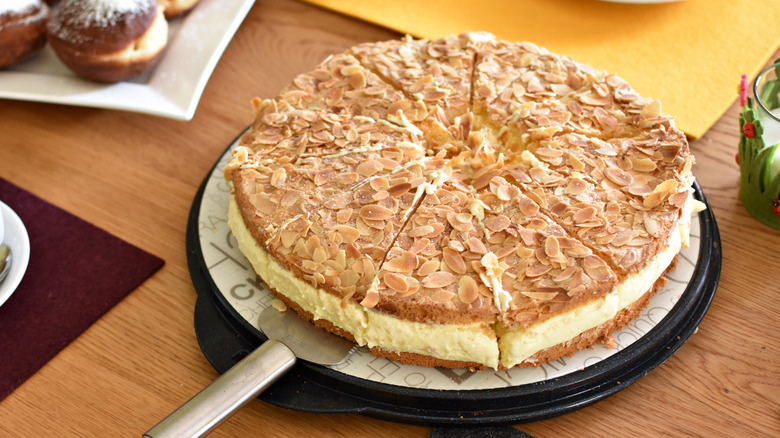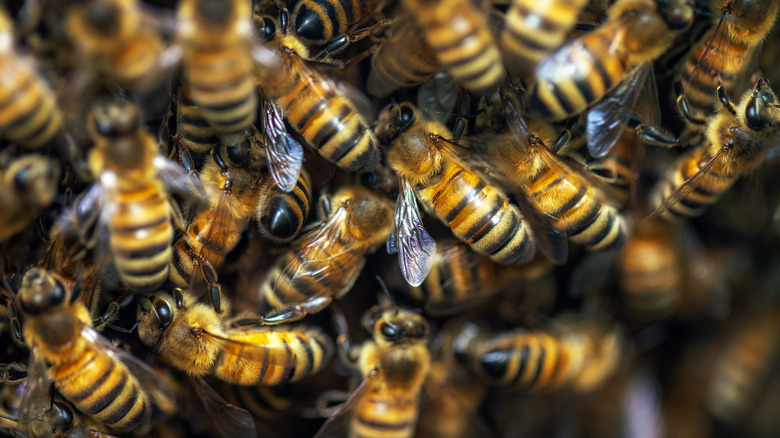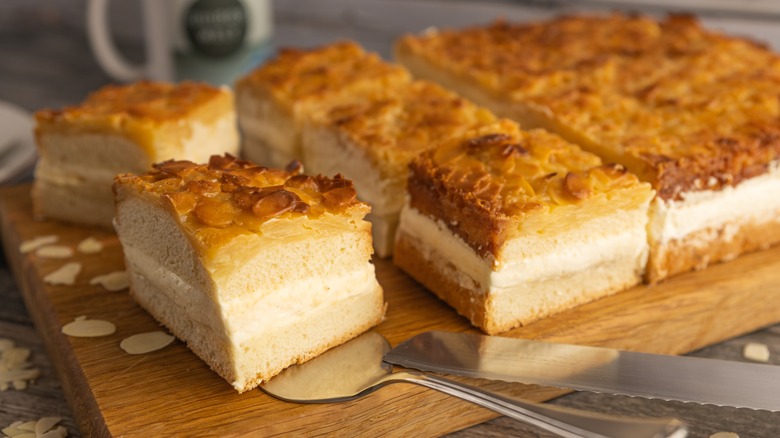What Is A German Bee Sting Cake, And How Did It Get Its Name?
Alongside stollen, strudel, and black forest cake, bee sting cake is a unique German dessert whose spongy base has a deliciously sweet taste and fascinating backstory. Luckily, no bees are harmed during the creation of this cake, and there's no need to worry about any stinging, either! The bee sting cake — bienenstich in German — traditionally has two layers of buttery cake that sandwich a rich custard filling. The yeast dough gives the cake a bread-like consistency, while the pastry cream is infused with flavorful vanilla. Topped with honey-glazed almonds, the cake is creamy and crunchy, comforting and delicious.
Best eaten the day it's baked, it's the perfect accompaniment to a cup of tea or coffee, and even after dinner. There are two tales that speak of the cake's origins. One is known as the baker boys legend, which is set in the Middle Ages. Another is a more recent theory that suggests a baker, stung by a bee drawn to the cake, consequently bestowed the cake with its name. Both are amusing tales, although the more recent version seems perhaps more likely, especially when considering the types of cake that were common during the Middle Ages. Let's explore them both.
The legend of bienenstich
One legend as to how bee sting cake got its name dates all the way back to 1474 when allegedly a feud between the people of a small town called Linz and the city of Andernach took place. Emperor Frederick III, who governed at the time, transferred toll-collecting rights from Linz to Andernach and since this was a major source of income, the citizens of Linz were upset. The people of Linz sought revenge and, in the dead of night, launched an attack on the city while it slept. Fortunately for the city of Andernach, two boys who had just finished a shift at a bakery were strolling home and snacking on honey from the beehives when they noticed the imminent siege.
They threw the hives down onto the attackers and out rushed all the bees, stinging the assailants and saving the city. The city celebrated the ingenuity of the boys and it is said that cake was served, thus called the bee sting cake.
Alternative theories
While the baker boys' tale is certainly entertaining, there are a couple of fatal flaws in the legend. The first is that the original version of this story did not mention cake. While the bakers are famed in Andernach for saving the city, the cake has made an appearance in their story only recently. Another is due to the creamy filling; this particular cake must be stored in a cool environment. During the 15th century when this story takes place, refrigerators didn't yet exist and it would have been bizarre to create a cake like this due to the high likelihood of its filling melting.
Another less adventurous but more realistic theory is that the filling itself is the inspiration for the name. The creamy vanilla custard, referred to as "Eierstich" or egg custard, is known to attract bees and insects who like sweet things. Thus the cake's name is likely to have been adapted from this. Like the mysterious German origins behind Baltimore's historic peach cake, bienenstich's exact origin story may never be known. If you ever get to taste this delightful cake, imagine the baker boys hurling the beehives to protect their city or a baker being stung by a bee and contemplate which backstory you prefer. Perhaps there's a little truth in both narratives; either way, this cake remains a delectable treat you must try.


